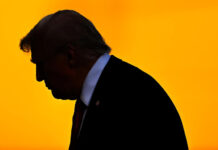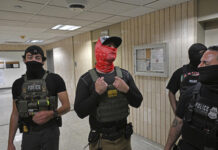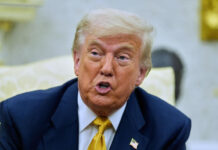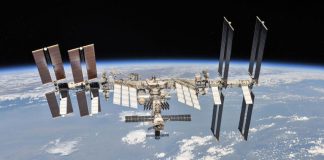DECEMBER 25, 2022
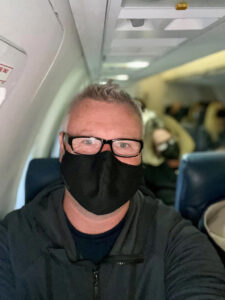
USA TODAY reporter Trevor Hughes on a United Express flight to Dulles International Airport on April 18, 2022.
DENVER, COLORADO – On seat 10D, my eyes flicker between my fellow passengers crammed in the aisle and the carbon dioxide detector balanced on my knee.
I can’t help but shudder a little every time someone coughs or sneezes as they board, and the numbers on the detector climb steadily, from about 800 parts per million to more than 1,600 ppm.
Experts say that the level of carbon dioxide in indoor air is an easy proxy for potential COVID-19 exposure, and now that masks are voluntary on planes and international arrivals no longer have to test, I wanted to see what my potential risk was.
Outdoor air typically has less than 400 ppm of carbon dioxide, and although the levels of CO2 on my plane never reach anything near what’s considered even mildly unhealthy, the numbers suggest I’m being exposed to coronavirus. I can’t help but touch my mask for reassurance.
I’m wearing a mask on this flight to visit my elderly parents in Vermont. The last time I visited, I was on one of the last mandatory masked flights, and I’ve taken several flights since then, sometimes masked, sometimes not.
Nationally, about 300 people a day are still dying of COVID-19. While rapid tests are now widely available, they only measure whether you’re infected. There’s no way to know about the people around you – especially when many people don’t seem to care whether they’re infected, or what the consequences could be for my parents or other at-risk communities.
That’s where the CO2 detector comes in. I bought a $140 KOPUO tester from Amazon, which an expert later tells me is one of the cheapest but still accurate detectors. Cheaper ones use a different measuring system that can be inaccurate if there’s a lot of hand sanitizer being used around it.
Why measure CO2?
An area with high CO2 levels may put you at higher risk for infection, while a space with low CO2 levels can be considered safer, says University of Colorado-Boulder professor Jose-Luis Jimenez.
Jimenez is an expert on how particles and gases move around a room, and he’s tested lots of inexpensive CO2 detectors and found that many are remarkably accurate compared to laboratory-grade equipment.
“It’s the only thing that we have found that approximates having this information,” Jimenez said. “It’s not perfect, because everyone exhales carbon dioxide, but not everyone who exhales has COVID.”
Jimenez and his colleagues found that in a library, if an influx of people makes CO2 levels double from 800 ppm to 1,600, COVID-19 transmission risk triples. And if CO2 levels in a gym drop from 2,800 ppm to 1,000, the risk of COVID-19 transmission drops 75%.
There are of course caveats to his models, particularly when it comes to masks, airplanes and HEPA filters. HEPA stands for “high-efficiency particulate air” and most large airplanes made by Boeing and Airbus have them installed. HEPA filters are effective at removing dust, pollen, bacteria and virus particles from the air, but they don’t remove carbon dioxide because it’s a dissolved gas with far smaller molecules.
Multiple studies conducted by the federal government, airlines, aircraft manufacturers and other researchers have concluded air travel poses a relatively low risk of COVID-19 infection, in large part because the HEPA filters remove virus particles. But that’s relevant only when the aircraft is pumping air through the filters. Airbus says its systems completely replace cabin air every 2-3 minutes while flying.
Measuring CO2 levels on my flight, at the airport
My measurements show CO2 levels skyrocketed during boarding of my Airbus A319 headed to Vermont, but remained virtually unchanged on my flight back to Denver. That indicates the pilot or ground crew were doing something different at boarding that kept the air fresher, even though both flights were similarly full and I was seated in almost the same place on both directions.
United Airlines did not respond to a request for comment on its specific policies, but sent a statement saying, in part, “There is always fresh air on the aircraft. The primary HEPA benefits are when airborne, because significant outdoor air is circulated through the cabin and jet bridge on the ground anyway.”
In the Denver International Airport terminal, the CO2 levels remained relatively consistent at about 800 ppm, and I felt comfortable removing my mask to wolf down some McDonald’s hash browns. The levels hit about 1,000 ppm on the airport train to the concourse, but sitting at the gate I was actually more concerned with how few men had washed their hands after using the restroom. That thought also made me shudder.
Aboard the plane, CO2 levels hit 1,520 ppm when flight attendants closed the boarding door, rose to about 1,800 when the pilot appeared to turn on a different ventilation system, dropped to about 1,600 as we taxied to the runway, and then jumped back to 1,900 as we approached the end of the runway for takeoff.
The levels began dropping immediately as the engines spooled up, and then leveled off around 1,200 as the seatbelt sign came off at 28,000 feet.
Watching the monitor, the levels rose back up to 1,550 as the flight attendants (one masked, one not) distributed cookies and then stayed at about that level until we landed. After getting off the plane in Burlington, the CO2 level was about 1,000 in the terminal, and I finally removed by mask.
Risk assessment
Returning home on Monday, the CO2 in the airport was about 400 ppm, which is the same level it was outside. The Burlington airport is far smaller than Denver’s, and fewer people were wearing masks, including me. The CO2 levels for the return flight topped out at about 1,000 ppm as the boarding door closed, and it dropped to about 850 at takeoff and remained there until we touched down in Denver.
Riding the train back from the concourse to the terminal, the CO2 level touched 650, significantly lower than my outbound ride. Given those lower levels, I felt reassured that leaving my mask off was a safe bet.
Jimenez said my behavior follows what’s known as a “budget of risk” – by using data, I adjusted my responses. Jimenez said he still wears N-95 masks on planes and tries to eat beforehand if it’s a short flight, but otherwise has to take it off when eating onboard. He said carrying around a CO2 detector has helped him make informed decisions about possible COVID-19 exposure.
“We are all being forced to do that,” he said of the constant decisions about risk. “We don’t want to live like monks.”
For me, the detector is an easy form of reassurance about my relative risks: Indoor areas with high levels of CO2 will prompt me to wear a mask, while areas with lower levels mean I can skip it.
Going forward, the proof will be in the pudding, as my parents like to say. And in this case, it means yet another negative COVID-19 test result upon my return to Denver.


